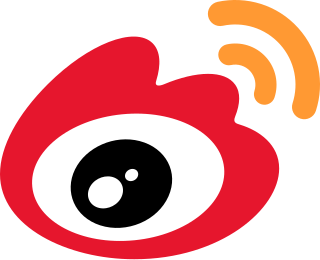
Personal web pages are World Wide Web pages created by an individual to contain content of a personal nature rather than content pertaining to a company, organization or institution. Personal web pages are primarily used for informative or entertainment purposes but can also be used for personal career marketing, social networking with other people with shared interests, or as a space for personal expression.
Social media optimization (SMO) is the use of a number of outlets and communities to generate publicity to increase the awareness of a product, service brand or event. Types of social media involved include RSS feeds, social news, bookmarking sites, and social networking sites such as Facebook, Instagram, Twitter, video sharing websites, and blogging sites. SMO is similar to search engine optimization (SEO) in that the goal is to generate web traffic and increase awareness for a website. SMO's focal point is on gaining organic links to social media content. In contrast, SEO's core is about reaching the top of the search engine hierarchy. In general, social media optimization refers to optimizing a website and its content to encourage more users to use and share links to the website across social media and networking sites.

X, formerly known as Twitter, is a social media website based in the United States. With over 500 million users, it is one of the world's largest social networks. Users can share and post text messages, images, and videos known historically as "tweets". X also includes direct messaging, video and audio calling, bookmarks, lists and communities, and Spaces, a social audio feature. Users can vote on context added by approved users using the Community Notes feature. Although the service is now called X, the primary domain name remains 'twitter.com' as at January 2024, with the 'x.com' URL redirecting to that address.
HCL Connections is a Web 2.0 enterprise social software application developed originally by IBM and acquired by HCL Technologies in July 2019. Connections is an enterprise-collaboration platform which aims to helps teams work more efficiently. Connections is part of HCL collaboration suite which also includes Notes / Domino, Sametime, Portal and Connections.
Microblogging is a form of blogging using short posts without titles known as microposts. Microblogs "allow users to exchange small elements of content such as short sentences, individual images, or video links", which may be the major reason for their popularity. Some popular social networks such as Twitter, Mastodon, Tumblr, Koo, and Instagram can be viewed as collections of microblogs.
Social network aggregation is the process of collecting content from multiple social network services into a unified presentation. Examples of social network aggregators include Hootsuite or FriendFeed, which may pull together information into a single location or help a user consolidate multiple social networking profiles into a single profile.
FriendFeed was a real-time feed aggregator that consolidated updates from social media and social networking websites, social bookmarking websites, blogs and microblogging updates, as well as any type of RSS/Atom feed. It was created in 2007 by Bret Taylor, Jim Norris, Paul Buchheit and Sanjeev Singh. It was possible to use this stream of information to create customized feeds to share, as well as originate new posts-discussions, with friends. Friendfeed was built on top of Tornado. The service was shut down at about 21:00 GMT on April 10, 2015, though the service blog announced it a month before.
Google Friend Connect was a free social networking site, active from 2008 to 2012. Similar to Facebook Platform and MySpaceID, it allowed users to build a profile to share and update information through messaging, photographs and video content via third-party sites which acted as a host for profile sharing and social exchanges.
Social network advertising, also known as "social media targeting," is a group of terms used to describe forms of online advertising and digital marketing focusing on social networking services. One of the significant benefits of this type of advertising is that advertisers can take advantage of the users' demographic information, psychographics and other data points to target their ads appropriately.

Bebo was an American social networking website that originally operated from 2005 until its bankruptcy in 2013 and relaunched in February 2021. The site relaunched several times after its bankruptcy with a number of short-lived offerings, including instant messaging and video streaming, until its acquisition by Amazon in July 2019 when it was shut down. It was announced in January 2021 that it would be returning as a new social media site the month after. By May 2022, it had once again been shut down, without having ever left beta testing.

Social media marketing is the use of social media platforms and websites to promote a product or service. Although the terms e-marketing and digital marketing are still dominant in academia, social media marketing is becoming more popular for both practitioners and researchers. Most social media platforms have built-in data analytics tools, enabling companies to track the progress, success, and engagement of social media marketing campaigns. Companies address a range of stakeholders through social media marketing, including current and potential customers, current and potential employees, journalists, bloggers, and the general public. On a strategic level, social media marketing includes the management of a marketing campaign, governance, setting the scope and the establishment of a firm's desired social media "culture" and "tone".

X Pro, formerly known as TweetDeck, is a paid proprietary social media dashboard for management of X accounts. Originally an independent app, TweetDeck was subsequently acquired by Twitter Inc. and integrated into Twitter's interface. It had long ranked as one of the most popular Twitter clients by percentage of tweets posted, alongside the official Twitter web client and the official apps for iPhone and Android.

Sysomos Inc. is a Toronto-based social media analytics company owned by Outside Insight market leaders Meltwater. The company developed text analytics and machine learning technologies for user generated content, and served 80% of the top agencies and Fortune 500.
Klout was a website and mobile app that used social media analytics to rate its users according to online social influence via the "Klout Score", which was a numerical value between 1 and 100. In determining the user score, Klout measured the size of a user's social media network and correlated the content created to measure how other users interact with that content. Klout launched in 2008.

Weibo, previously Sina Weibo, is a Chinese microblogging (weibo) website. Launched by Sina Corporation on 14 August 2009, it is one of the biggest social media platforms in China, with over 582 million monthly active users as of Q1 2022. The platform has been a huge financial success, with surging stocks, lucrative advertising sales and high revenue and total earnings per quarter. At the start of 2018, it surpassed the US$30 billion market valuation mark for the first time.
Reblogging is the mechanism in blogging which allows users to repost the content of another user's post with an indication that the source of the post is another user.

Google+ was a social network that was owned and operated by Google until it ceased operations in 2019. The network was launched on June 28, 2011, in an attempt to challenge other social networks, linking other Google products like Google Drive, Blogger and YouTube. The service, Google's fourth foray into social networking, experienced strong growth in its initial years, although usage statistics varied, depending on how the service was defined. Three Google executives oversaw the service, which underwent substantial changes that led to a redesign in November 2015.
A real-name system is a system in which users can register an account on a blog, website or bulletin board system using their legal name.

Mastodon is a free and open-source software for running self-hosted social networking services. It has microblogging features similar to Twitter, which are offered by a large number of independently run nodes, known as instances or servers, each with its own code of conduct, terms of service, privacy policy, privacy options, and content moderation policies.
Micro.blog is a microblogging and social networking service created by Manton Reece. It is the first large multi-user social media service to support the Webmention and Micropub standards published by the World Wide Web Consortium, and is part of the Fediverse, supporting ActivityPub.









